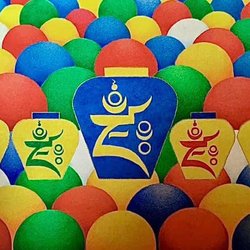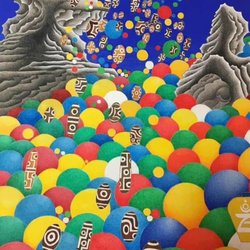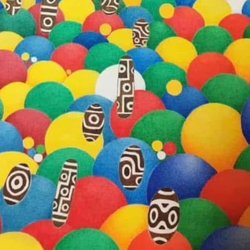Kharchen Tsogyel Dzambhala (mKha chen mTsho rGyal dzam bha la / མཁ་ཆེན་མཚོ་རྒྱལ་ཛྃ་བྷ་ལ་). Jomo Yeshé Tsogyel manifesting in the form of the Yidam of intrinsic wealth and pervasive generosity. This was painted by Naljorma Sônam — one of the thangka painting students of Khandro Déchen.
There are nine thangka artists, trained by Khandro Déchen, in the Aro Dri-ku (A ro bris sKu / ཨ་རོ་བྲིས་སྐུ་) style inaugurated by ‘Khordong gTérchen Tulku Chhi’mèd Rig’dzin Rinpoche.
This style is based on Karma Gadri — but employs the vividness of colour more typical of thangka styles prior to the 1950s. Aro Dri-ku employs a slightly greater degree of realism in terms of the physical form of yidams. This is one of the central features recommended by ‘Khordong gTérchen Tulku Chhi’mèd Rig’dzin Rinpoche.
The 111 yidam cycle of the Aro gTérmas of Khyungchen Aro Lingma are all manifestations of Guru Rinpoche and Yeshé Tsogyel. There is therefore an Ögyen Dzambhala and a Kharchen Tsogyel Dzambhala — both of whom function as yidams in terms of realisation the natural wealth inherent in the senses and fields of the senses.
This is Yeshé Tsogyel as the great wealth protector in yidam form. Wealth in her terms, is the extent of individual appreciation rather the financial collateral or materiel possessions. Here follows an extract from her envisionment text.
Here follows an extract from the envisionment text:
༄From lucid shining emptiness. Instantaneously arising. Vividly flamboyant Kharchen Tsogyel Dzambhala. Gracious wealth protector, compassionately contemptuous of parsimonious penury. Wrathfully magnanimous. Bountifully authoritative. Enriching all beings, conditions, and situations.
Yellow complexion. Vast golden depth reflects endless wealth and generosity brimming within every jewel facet of nonduality.
Copious bright copper hair spills in wild profusion from an auriferous vajra crown.
Naked to the upper thighs. Extravagant display. Sumptuous availability of natural phenomenal affluence. Dramatically opulent breasts. dKyil’khor thig-nyi adorned with numa yati circles of manifestation. Beautiful rounded belly—dro-khog chenmo—adorned with trulku’i ’khorlo circle of emanation.
Guardian of the South wearing luxurious floral ornamented armour skirts. Golden armour skirts displaying fertile qualities of mid-morning — pregnant with possibilities. Amber armour skirts displaying ripened qualities of the Autumn — season of abundance, fruition, and prodigality.
Amber khatvangha resting in the right arm is Rinchen Guru Rinpoche. Glimmering gesture of internal treasure, Secret spacious method nature. Mongoose carried in the right arm-crook distributes myriad gZis from its upper and lower gates.
Left hand holding the golden five-pronged wrathful vajra which overpowers all apparent phenomena in opulence-emptiness. From the tip of the indestructible sceptre fly three rainbow-coloured garudas – each holding earth and space jewels in the form of g.Yung drung. Essence of form and emptiness. Symbols of earth and sky — repositories of infinite wealth. Earth: the infinite repository of manifested compassionate-riches of being. Sky: the infinite repository of unmanifested wisdom-riches of being.
Surrounded by shimmering clouds of the five colours. Magnificently rugged landscape providing physical reflections of pristine presumption, vajra insolence, and indestructible ostentation.
Mountainous munificence and stance of hauteur betokens ability to stride with savage aplomb into active largesse for the splendorous nondual enrichment of everyone and everything everywhere.
“‘Religion is a manifestation of the Arts as applied to the development of the individual and the entire environment of beings and phenomena. It is the assumption of responsibility for the phenomenal world and the evident inhabitants.
―Ngak’chang Rinpoche and Khandro Déchen
Religion does not have to be institutionalised — but it does involve cooperation and mutual respect. It allows freedom but demands the maintenance of standards in creativity and kindness. It honours its history whilst leaving scope for its future in relation to the needs of those who depend upon it.’”











